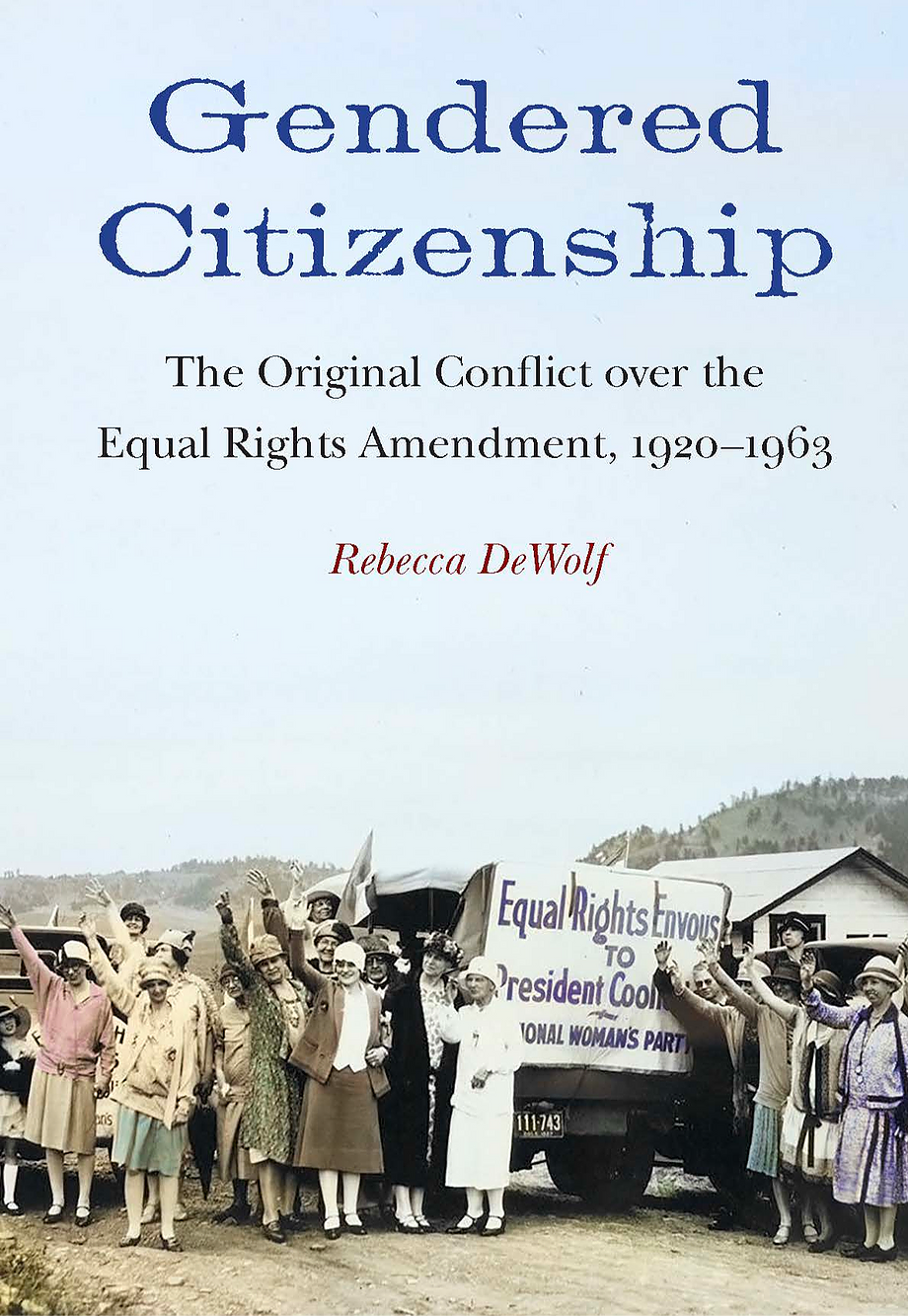The Book
Gendered Citizenship: The Original Conflict Over the Equal Rights Amendment, 1920-1963. The University of Nebraska Press, 2021.
The Author(s)
Rebecca DeWolf

Considering the Equal Rights Amendment (ERA) might call to mind a scene from The West Wing, where Republican token character Ainsley Hayes vilifies the proposed amendment. “I’m a low maintenance lady, I’ve got the Fourteenth Amendment,” Hayes sighs, “I’m mortified there’s reason to believe I wasn’t” equal under the law. “I’m not a special subset in need of your protection,” Hayes continues, unintentionally echoing the decades-earlier position of emancipationism, or anti-protectionism, which ironically supported the ERA. While Hayes doesn’t want her “rights handed down… by a bunch of old white men,” ERA’s early history was, to the contrary, a story of women.
Drafted by Alice Paul in 1921 and passed by both houses of Congress in 1972 – before being rejected by the states – the ERA would’ve amended the Constitution to declare gender equality under the law. In 1920, the Nineteenth Amendment had granted women the right to vote, therefore adding gender equality for voting but not gender equality more broadly. Author and historian Rebecca DeWolf’s new book Gendered Citizenship: The Original Conflict over the Equal Rights Amendment, 1920-1963, asks what it means for citizenship that only voting rights are guaranteed under the Constitution while total equality is not. DeWolf answers by tracing two competing perspectives on the original ERA debates from 1920 to 1963. She calls them emancipationists versus protectionists. DeWolf concludes that they were not competing feminist ideologies, but instead they revealed competing views of citizenship. DeWolf argues that while both emancipationists and protectionists wanted to support women, their contradictory approaches signified a conflict over the meaning of citizenship.
While Gendered Citizenship is readable with a spirited focus on equal rights for women, its foremost strength is defining terms while bearing out nuances to trace historical origins of the ERA debates to illuminate more recent history.
Gender inequality and sexism angered the emancipationists. They responded by promoting a Constitutional Amendment to declare gender equality, rendering sexism unconstitutional. Yet, gender equality and sexism angered protectionists, too. Protectionists worried that the ERA could blind lawmakers to the realities of sexism, arguing that individual laws should offer special protections for women. Notable protectionists included Eleanor Roosevelt and Frances Perkins, who both favored special protections for women instead of the ERA, even as emancipationism gained traction throughout the Great Depression and World War II.
Throughout her book, DeWolf draws from congressional testimony, legal documents, letters, speeches, and more. Chapter one focuses on debates over women’s citizenship immediately after the ratification of the Nineteenth Amendment in 1920. Chapter two introduces emancipationism and protectionism within the process of drafting the ERA in the early 1920s. Chapters three and four argue that the Great Depression and World War II revitalized emancipationism in the 1930s and 1940s respectively. Chapters five and six relay the victory of protectionism through protectionist legislation. Such legislation re-enforced and advanced protections from the Fourteenth Amendment, setting precedent for the long-term victory of individual laws over a federal ERA.
Readers might wonder, how on earth did DeWolf’s protectionists and emancipationists – both counting feminist progressives among their ranks – devolve into the polarizing liberal ERA-supporters versus conservative Ainsley Hayes types? DeWolf’s epilogue answers that “societal developments had enhanced the liberal aspects of emancipationism and the conservative elements of protectionism” (217). Emancipationists embraced a modern understanding of the distinction between gender and sex, desiring equal rights across the gender spectrum. Protectionists, however, clung to what DeWolf calls a “gendered citizenship,” insisting “that complete constitutional sexual equality would endanger the American family and imperil American society” (216). Now that sounds more like Ainsley Hayes.
DeWolf guides readers back to the original ERA conflict to dissect its roots, explicate what it meant, and trace how lingering gender inequality stems from it. Although the original conflict over the ERA was the topic of the author’s doctoral dissertation, Gendered Citizenship doesn’t read like a dense or jargon-filled dissertation at all. To the contrary, the clear organization and careful wording suggest the most thoughtful approaches to content and writing between DeWolf’s doctoral defense in 2015, and her book’s publication in 2021. Gendered Citizenship is a must-read for history lovers, policy wonks, women’s rights activists, and anyone else interested in how the U.S. government can support gender equality.

0